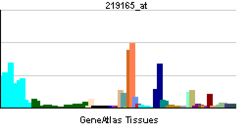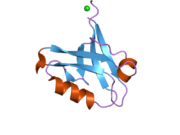- PDLIM2
-
PDZ and LIM domain 2 (mystique) 
PDB rendering based on 2pa1.Available structures PDB 2pa1 Identifiers Symbols PDLIM2; FLJ34715; MYSTIQUE; SLIM External IDs OMIM: 609722 MGI: 2384850 HomoloGene: 11006 GeneCards: PDLIM2 Gene Gene Ontology Molecular function • zinc ion binding
• metal ion bindingCellular component • nucleus
• cytoplasm
• focal adhesion
• cell surface
• actin cytoskeletonSources: Amigo / QuickGO RNA expression pattern 
More reference expression data Orthologs Species Human Mouse Entrez 64236 213019 Ensembl ENSG00000120913 ENSMUSG00000022090 UniProt Q96JY6 Q3UUU5 RefSeq (mRNA) NM_021630.5 NM_145978.1 RefSeq (protein) NP_067643.3 NP_666090.1 Location (UCSC) Chr 8:
22.44 – 22.46 MbChr 14:
70.56 – 70.58 MbPubMed search [1] [2] PDZ and LIM domain protein 2 is a protein that in humans is encoded by the PDLIM2 gene.[1]
References
Further reading
- Bonaldo MF, Lennon G, Soares MB (1997). "Normalization and subtraction: two approaches to facilitate gene discovery.". Genome Res. 6 (9): 791–806. doi:10.1101/gr.6.9.791. PMID 8889548.
- Hattori A, Okumura K, Nagase T et al. (2001). "Characterization of long cDNA clones from human adult spleen". DNA Res. 7 (6): 357–66. doi:10.1093/dnares/7.6.357. PMID 11214971.
- Strausberg RL, Feingold EA, Grouse LH et al. (2003). "Generation and initial analysis of more than 15,000 full-length human and mouse cDNA sequences". Proc. Natl. Acad. Sci. U.S.A. 99 (26): 16899–903. doi:10.1073/pnas.242603899. PMC 139241. PMID 12477932. http://www.pubmedcentral.nih.gov/articlerender.fcgi?tool=pmcentrez&artid=139241.
- Shin BK, Wang H, Yim AM et al. (2003). "Global profiling of the cell surface proteome of cancer cells uncovers an abundance of proteins with chaperone function". J. Biol. Chem. 278 (9): 7607–16. doi:10.1074/jbc.M210455200. PMID 12493773.
- Ota T, Suzuki Y, Nishikawa T et al. (2004). "Complete sequencing and characterization of 21,243 full-length human cDNAs". Nat. Genet. 36 (1): 40–5. doi:10.1038/ng1285. PMID 14702039.
- Gerhard DS, Wagner L, Feingold EA et al. (2004). "The Status, Quality, and Expansion of the NIH Full-Length cDNA Project: The Mammalian Gene Collection (MGC)". Genome Res. 14 (10B): 2121–7. doi:10.1101/gr.2596504. PMC 528928. PMID 15489334. http://www.pubmedcentral.nih.gov/articlerender.fcgi?tool=pmcentrez&artid=528928.
- Wan D, Gong Y, Qin W et al. (2004). "Large-scale cDNA transfection screening for genes related to cancer development and progression". Proc. Natl. Acad. Sci. U.S.A. 101 (44): 15724–9. doi:10.1073/pnas.0404089101. PMC 524842. PMID 15498874. http://www.pubmedcentral.nih.gov/articlerender.fcgi?tool=pmcentrez&artid=524842.
- Loughran G, Healy NC, Kiely PA et al. (2005). "Mystique Is a New Insulin-like Growth Factor-I-regulated PDZ-LIM Domain Protein That Promotes Cell Attachment and Migration and Suppresses Anchorage-independent Growth". Mol. Biol. Cell 16 (4): 1811–22. doi:10.1091/mbc.E04-12-1052. PMC 1073663. PMID 15659642. http://www.pubmedcentral.nih.gov/articlerender.fcgi?tool=pmcentrez&artid=1073663.
- Tanaka T, Grusby MJ, Kaisho T (2007). "PDLIM2-mediated termination of transcription factor NF-kappaB activation by intranuclear sequestration and degradation of the p65 subunit". Nat. Immunol. 8 (6): 584–91. doi:10.1038/ni1464. PMID 17468759.
PDB gallery Categories:- Human proteins
- Chromosome 8 gene stubs
Wikimedia Foundation. 2010.

